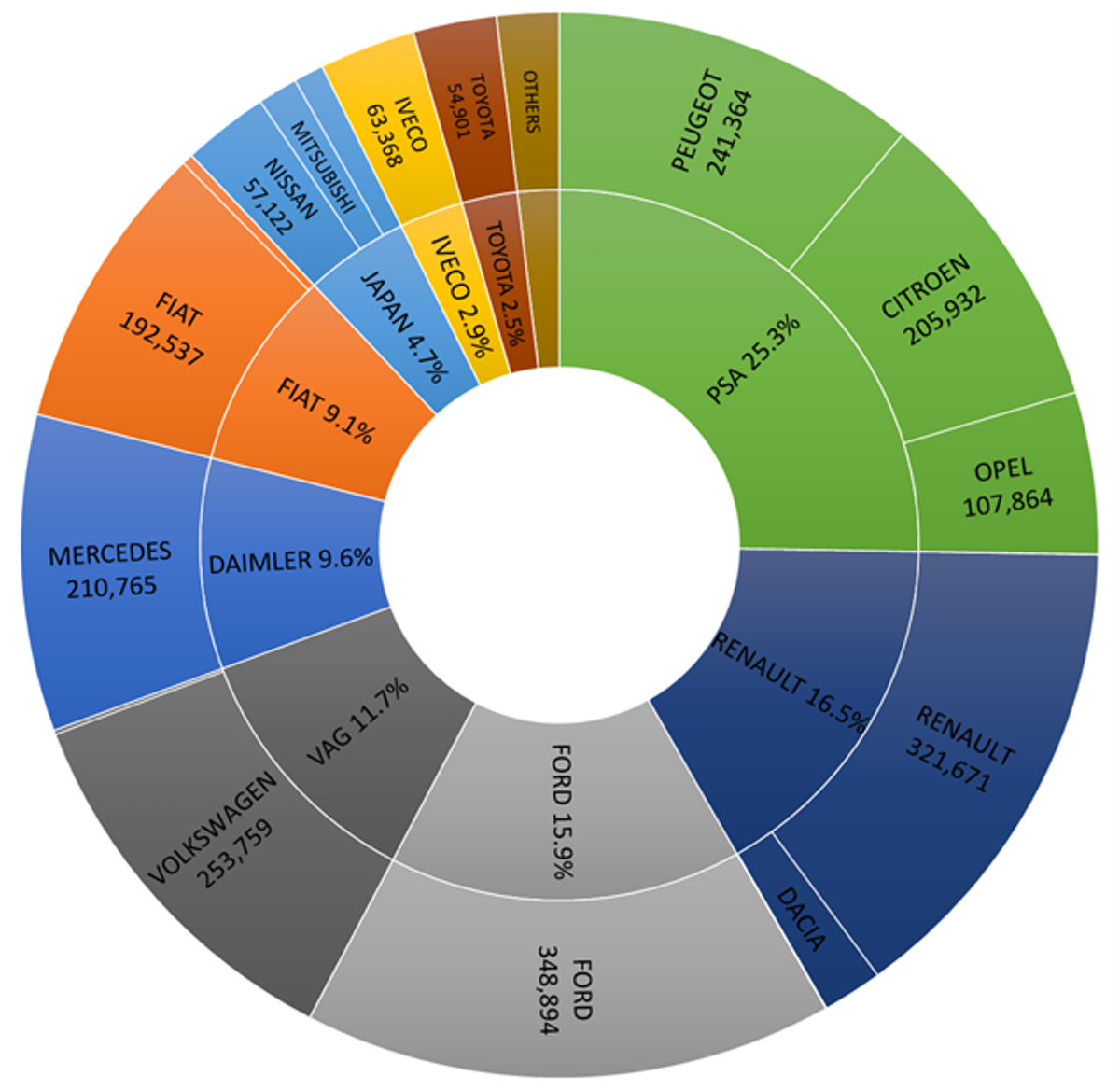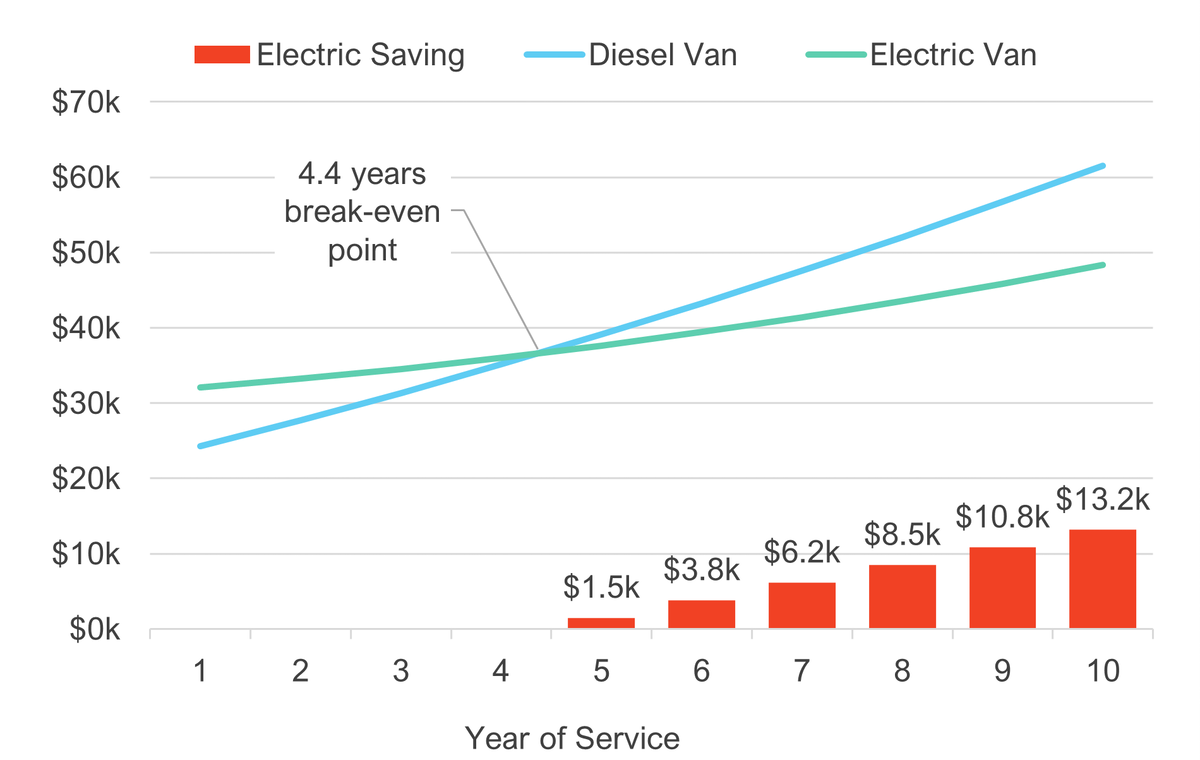|
1. |
EXECUTIVE SUMMARY |
|
1.1. |
Imminent Boom in eLCVs |
|
1.2. |
Electric LCV Unit Sales BEV, PHEV, FCEV 2017-2041 |
|
1.3. |
Electric LCVs and Covid-19 |
|
1.4. |
Plug-in hybrid LCVs |
|
1.5. |
Global Forecast Takeaways |
|
1.6. |
Forecast Takeaways |
|
1.7. |
eLCV (BEV, PHEV, FCEV) sales by region 2017-2041 (000s units) |
|
1.8. |
eLCV (BEV, PHEV, FCEV) battery forecast by region 2017-2041 (GWh) |
|
1.9. |
eLCV market revenue forecast by region 2017-2041 ($US billion) |
|
2. |
INTRODUCTION |
|
2.1. |
Electric Vehicle Terms |
|
2.2. |
Electric Vehicles: Basic Principle |
|
2.3. |
Electric Vehicles: Typical Specs |
|
2.4. |
LCV Definition |
|
2.5. |
Different segments of goods transportation by land |
|
2.6. |
Types of popular on-road truck |
|
2.7. |
LCV fleet description by region |
|
2.8. |
The Core Driver: Climate Change |
|
2.9. |
Global CO2 emission from transport |
|
2.10. |
CO2 emissions from the LCV sector |
|
2.11. |
CO2 emission from the LCV sector |
|
2.12. |
Urban air quality |
|
2.13. |
Urban air quality |
|
2.14. |
Urban air quality |
|
2.15. |
Pollution in India |
|
2.16. |
Road transport the main source of urban NOx |
|
2.17. |
Fossil Fuel Bans: Explained |
|
2.18. |
Official or Legislated Fossil Fuel Bans (National) |
|
2.19. |
Unofficial, Drafted or Proposed Fossil Fuel Bans (National) |
|
2.20. |
Fossil Fuel Bans (Cities) |
|
2.21. |
The worldwide freight transport industry |
|
2.22. |
Road Freight Market |
|
2.23. |
Projected increase in global road freight activity |
|
2.24. |
The rise of e-commerce: increased freight demand |
|
2.25. |
Fuel / emissions regulation for new LCVs |
|
2.26. |
GHG emission from LCVs |
|
2.27. |
Europe Emissions Standards: LCVs |
|
2.28. |
Drivers for LCV Electrification |
|
2.29. |
eLCV Market Drivers |
|
2.30. |
Considerations for eLCV adoption |
|
2.31. |
Do eLCVs offer sufficient range? |
|
2.32. |
Do eLCVs offer sufficient range? |
|
2.33. |
Do eLCVs offer sufficient range? |
|
2.34. |
Do eLCVs offer sufficient range? |
|
3. |
IDTECHEX TCO CALCULATIONS |
|
3.1. |
Total Cost of Ownership |
|
3.2. |
Environmental goodwill insufficient for uptake of eLCV |
|
3.3. |
TCO considerations for eLCV |
|
3.4. |
Overcoming barriers for low emission technologies |
|
3.5. |
Example: TCO for eLCV (Renault Kangoo) |
|
3.6. |
Example: TCO for eLCV (Nissan e-NV200) |
|
3.7. |
Timeline for TCO parity between diesel and eLCV |
|
3.8. |
Electric and diesel LCV cost parity |
|
3.9. |
IDTechEx Battery-Electric Van TCO Analysis |
|
3.10. |
TCO: Small Vans |
|
3.11. |
TCO Analysis Assumptions: Small Van |
|
3.12. |
Small eVan Break-Even Point |
|
3.13. |
Small eVan Break-Even: Purchase Grant |
|
3.14. |
Small eVan Break-Even: Daily Duty Cycle Range |
|
3.15. |
TCO: Medium Vans |
|
3.16. |
TCO Analysis Assumptions: Medium Van |
|
3.17. |
Medium eVan Break-Even Without Purchase Grant |
|
3.18. |
Medium eVan Break-Even: Purchase Grant |
|
3.19. |
Medium eVan Break-Even: Daily Duty Cycle Range |
|
3.20. |
TCO: Large Vans |
|
3.21. |
TCO Analysis Assumptions: Large Van |
|
3.22. |
Large eVan Break-Even Without Purchase Grant |
|
3.23. |
Large eVan Break-Even: Purchase Grant |
|
3.24. |
Large eVan Break-Even: Daily Duty Cycle Range |
|
3.25. |
TCO Summary: Small, Medium and Large Electric Vans |
|
3.26. |
Strengthening TCO advantage for eVans |
|
4. |
EUROPE |
|
4.1. |
Europe: LCV sales 2019 |
|
4.2. |
European market for LCVs |
|
4.3. |
European in-use LCV fleet and new registrations |
|
4.4. |
New registrations in Europe's 8 largest LCV fleets |
|
4.5. |
2018 European eLCV Sales |
|
4.6. |
2019 European eLCV Sales |
|
4.7. |
Increasing eLCV sales in Europe |
|
4.8. |
Market outlook: national and local policy |
|
4.9. |
European eLCV market leaders |
|
4.10. |
Popular e-LCVs in Europe |
|
4.11. |
StreetScooter Timeline |
|
4.12. |
StreetScooter: End of the Road |
|
4.13. |
2019 Rise of the large eLCV? |
|
4.14. |
Movers 2019: Daimler enter the fray |
|
4.15. |
Vastly increasing eVan model choice |
|
4.16. |
New e-LCV models |
|
4.17. |
Ford Transit Custom PHEV |
|
4.18. |
Available PHEV LCVs |
|
4.19. |
Plug-in hybrid LCVs |
|
4.20. |
2020 Large Orders for eLCV |
|
4.21. |
A New Arrival |
|
4.22. |
Arrival's Business Model |
|
4.23. |
Specifications of eLCVs available in Europe |
|
4.24. |
e-LCVs in Europe: compact utility vehicles |
|
4.25. |
UK Electric Fleets Coalition |
|
5. |
ELCVS IN CHINA |
|
5.1. |
Chinese Market for LCVs |
|
5.2. |
China: Electric Special-Purpose Vehicle Sales 2018 |
|
5.3. |
China: Commercial Vehicle Sales 2019 |
|
5.4. |
China: SPV Production 2018 Top 15 Manufacturers |
|
5.5. |
China: Electric SPV Production 2019 |
|
5.6. |
China NEV eLCV production / sales fall in 2019 |
|
5.7. |
Best selling new energy LCVs in China |
|
5.8. |
Best selling new energy LCVs in China |
|
5.9. |
Popular Larger Electric LCVs in China |
|
5.10. |
China: Main Battery Suppliers to Chinese eLCVs |
|
5.11. |
Battery suppliers to the Chinese NEV SPV Market |
|
5.12. |
China: Main Motor Suppliers to Chinese eLCVs |
|
5.13. |
Drivers for the electrification of LCVs in China |
|
5.14. |
City Targets |
|
5.15. |
Market Outlook: China eLCVs |
|
5.16. |
China to support e-SPV sales in 2nd and 3rd Tier Cities |
|
5.17. |
BAIC EV5 with UV disinfection to counter covid-19 |
|
6. |
ELCVS IN THE US |
|
6.1. |
US: Commercial LCV Sales 2018 |
|
6.2. |
US: Commercial LCV Sales 2019 |
|
6.3. |
Growth in US commercial LCV sales |
|
6.4. |
US LCV Sales by OEM |
|
6.5. |
California's Advanced Clean Trucks Regulation |
|
6.6. |
CARB Voucher Incentive Project |
|
6.7. |
Lightning Systems - Electric Ford Transit Cargo LCV |
|
6.8. |
Workhorse C-Series Electric Delivery Trucks |
|
6.9. |
Rivian / Amazon electric delivery LCV |
|
6.10. |
Rivian: Three sizes of delivery LCV for Amazon |
|
6.11. |
Bollinger Motors Deliver-E All-Electric Concept LCV |
|
6.12. |
Karma Automotive E-Flex Utility LCV |
|
6.13. |
Ford: Finally an OEM offering an eVan option in the US |
|
6.14. |
General Motors All-Electric Delivery LCV BV1 |
|
6.15. |
Popular Electric LCVs in the US |
|
6.16. |
eLCV Demand: Corporate Electric Vehicle Alliance |
|
6.17. |
Business to drive electrification of LCV fleet in US? |
|
7. |
ELCVS IN THE ROW |
|
7.1. |
Toyota PROACE |
|
7.2. |
Yamato / DHL StreetScooter |
|
7.3. |
Mitsubishi MiniCab MiEV LCV |
|
7.4. |
Hyundai Porter EV and Kia Bongo EV |
|
7.5. |
Tata Motors Ace |
|
7.6. |
Mahindra eSupro Cargo LCV |
|
7.7. |
Mahindra and REE eLCV Partnership |
|
7.8. |
Maruti Suzuki India Eeco Charge Concept |
|
7.9. |
Croyance Electro 1.T and Electro 2.T |
|
7.10. |
SEA E4V Delivery LCV |
|
8. |
TECHNOLOGIES |
|
8.1. |
Li-ion Batteries |
|
8.1.1. |
What is a Li-ion battery? |
|
8.1.2. |
The Battery Trilemma |
|
8.1.3. |
Electrochemistry Definitions |
|
8.1.4. |
Lithium-based Battery Family Tree |
|
8.1.5. |
Battery Wish List |
|
8.1.6. |
More Than One Type of Li-ion battery |
|
8.1.7. |
NMC: from 111 to 811 |
|
8.1.8. |
Cobalt: Price Volatility |
|
8.1.9. |
Cathode Performance Comparison |
|
8.1.10. |
811 Commercialisation Examples |
|
8.1.11. |
Commercial Anodes: Graphite |
|
8.1.12. |
The Promise of Silicon-based Anodes |
|
8.1.13. |
The Reality of Silicon |
|
8.1.14. |
Silicon: Incremental Steps |
|
8.1.15. |
What is in a Cell? |
|
8.1.16. |
Inactive Materials Negatively Affect Energy Density |
|
8.1.17. |
Commercial Battery Packaging Technologies |
|
8.1.18. |
Comparison of Commercial Cell Geometries |
|
8.1.19. |
What is NCMA? |
|
8.1.20. |
Lithium-based Batteries Beyond Li-ion |
|
8.1.21. |
Li-ion Chemistry Snapshot: 2020, 2025, 2030 |
|
8.2. |
Electric Traction Motors |
|
8.2.1. |
Electric Traction Motors: Introduction |
|
8.2.2. |
Electric Traction Motors: Introduction |
|
8.2.3. |
Brushless DC Motors (BLDC): Working Principle |
|
8.2.4. |
BLDC Motors: Advantages, Disadvantages |
|
8.2.5. |
BLDC Motors: Benchmarking Scores |
|
8.2.6. |
Permanent Magnet Synchronous Motors (PMSM): Working Principle |
|
8.2.7. |
PMSM: Advantages, Disadvantages |
|
8.2.8. |
PMSM: Benchmarking Scores |
|
8.2.9. |
Wound Rotor Synchronous Motor (WRSM): Working Principle |
|
8.2.10. |
WRSM Motors: Benchmarking Scores |
|
8.2.11. |
WRSM: Advantages, Disadvantages |
|
8.2.12. |
AC Induction Motors (ACIM): Working Principle |
|
8.2.13. |
AC Induction Motor (ACIM) |
|
8.2.14. |
AC Induction Motors: Benchmarking Scores |
|
8.2.15. |
AC Induction Motor: Advantages, Disadvantages |
|
8.2.16. |
Reluctance Motors |
|
8.2.17. |
Reluctance Motor: Working Principle |
|
8.2.18. |
Switched Reluctance Motor (SRM) |
|
8.2.19. |
Switched Reluctance Motors: Benchmarking Scores |
|
8.2.20. |
Permanent Magnet Assisted Reluctance (PMAR) |
|
8.2.21. |
PMAR Motors: Benchmarking Scores |
|
8.3. |
Electric Traction Motors: Summary and Benchmarking Results |
|
8.3.1. |
Comparison of Traction Motor Construction and Merits |
|
8.3.2. |
Benchmarking Electric Traction Motors |
|
8.3.3. |
Motor Efficiency Comparison |
|
8.3.4. |
Magnet Price Increase? |
|
8.3.5. |
Multiple Motors: Explained |
|
8.3.6. |
LCVs & Trucks |
|
8.3.7. |
Motors per Vehicle and kWp per Vehicle Assumptions |
|
8.3.8. |
Brushed DC: Small Presence in LCVs |
|
8.3.9. |
LCVs and Trucks Motor Outlook |
|
8.4. |
Fuel Cells |
|
8.4.1. |
Proton Exchange Membrane Fuel Cells |
|
8.4.2. |
Fuel Cell Inefficiency and Cooling Methods |
|
8.4.3. |
Challenges for Fuel Cells |
|
8.4.4. |
Infrastructure Costs |
|
8.4.5. |
Fuel Cell Charging Infrastructure in the US |
|
8.4.6. |
Fuel Cost per Mile: FCEV, BEV, internal-combustion |
|
8.4.7. |
Fuel Cell LCVs |
|
8.4.8. |
Example Fuel Cell LCV Specifications |
|
8.4.9. |
Outlook for Fuel Cell LCVs |
|
9. |
FORECASTS |
|
9.1. |
Forecast Assumptions |
|
9.2. |
Forecast Methodology |
|
ページTOPに戻る
本レポートと同じKEY WORD()の最新刊レポート
- 本レポートと同じKEY WORDの最新刊レポートはありません。
よくあるご質問
IDTechEx社はどのような調査会社ですか?
IDTechExはセンサ技術や3D印刷、電気自動車などの先端技術・材料市場を対象に広範かつ詳細な調査を行っています。データリソースはIDTechExの調査レポートおよび委託調査(個別調査)を取り扱う日... もっと見る
調査レポートの納品までの日数はどの程度ですか?
在庫のあるものは速納となりますが、平均的には 3-4日と見て下さい。
但し、一部の調査レポートでは、発注を受けた段階で内容更新をして納品をする場合もあります。
発注をする前のお問合せをお願いします。
注文の手続きはどのようになっていますか?
1)お客様からの御問い合わせをいただきます。
2)見積書やサンプルの提示をいたします。
3)お客様指定、もしくは弊社の発注書をメール添付にて発送してください。
4)データリソース社からレポート発行元の調査会社へ納品手配します。
5) 調査会社からお客様へ納品されます。最近は、pdfにてのメール納品が大半です。
お支払方法の方法はどのようになっていますか?
納品と同時にデータリソース社よりお客様へ請求書(必要に応じて納品書も)を発送いたします。
お客様よりデータリソース社へ(通常は円払い)の御振り込みをお願いします。
請求書は、納品日の日付で発行しますので、翌月最終営業日までの当社指定口座への振込みをお願いします。振込み手数料は御社負担にてお願いします。
お客様の御支払い条件が60日以上の場合は御相談ください。
尚、初めてのお取引先や個人の場合、前払いをお願いすることもあります。ご了承のほど、お願いします。
データリソース社はどのような会社ですか?
当社は、世界各国の主要調査会社・レポート出版社と提携し、世界各国の市場調査レポートや技術動向レポートなどを日本国内の企業・公官庁及び教育研究機関に提供しております。
世界各国の「市場・技術・法規制などの」実情を調査・収集される時には、データリソース社にご相談ください。
お客様の御要望にあったデータや情報を抽出する為のレポート紹介や調査のアドバイスも致します。
|
|





